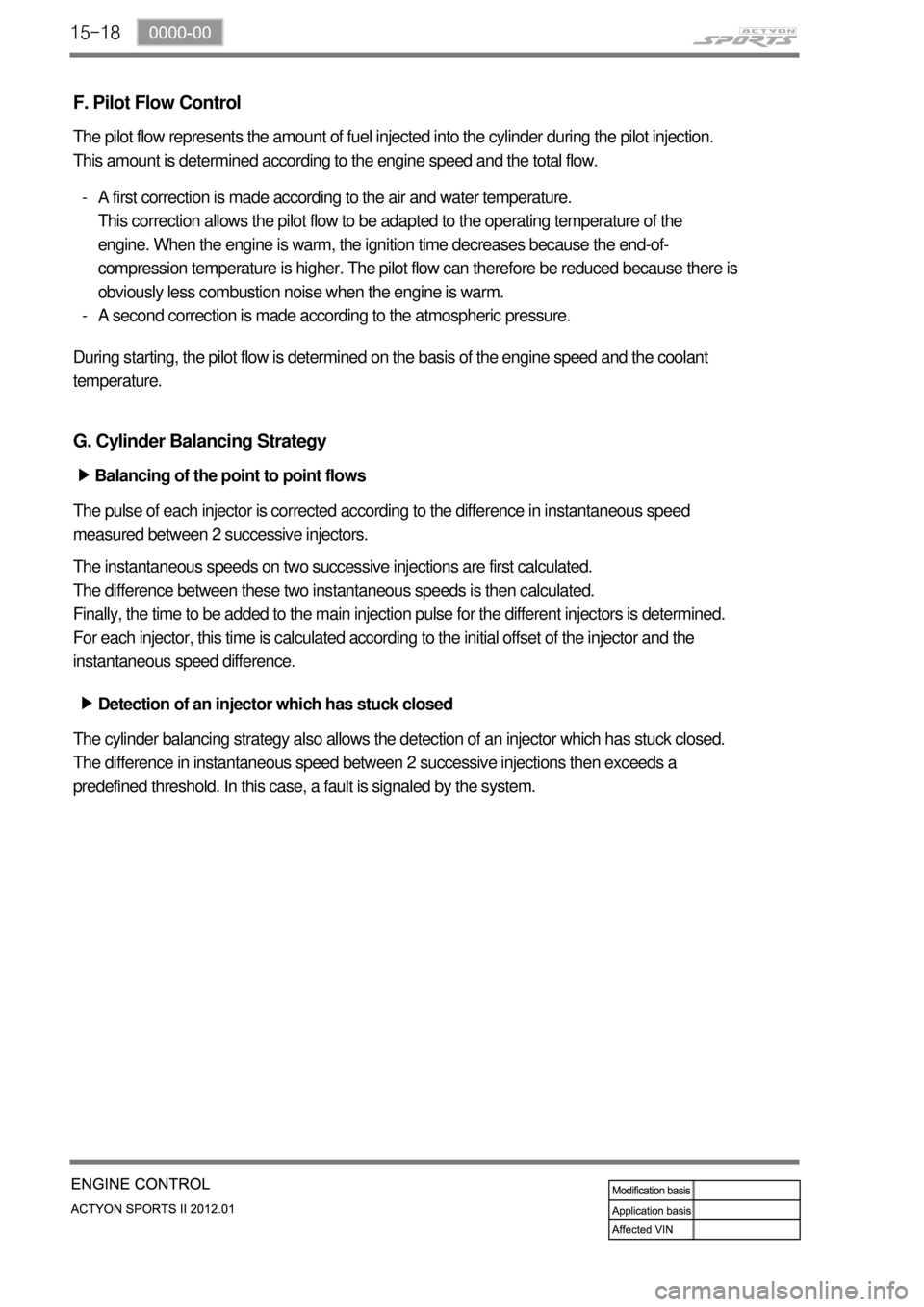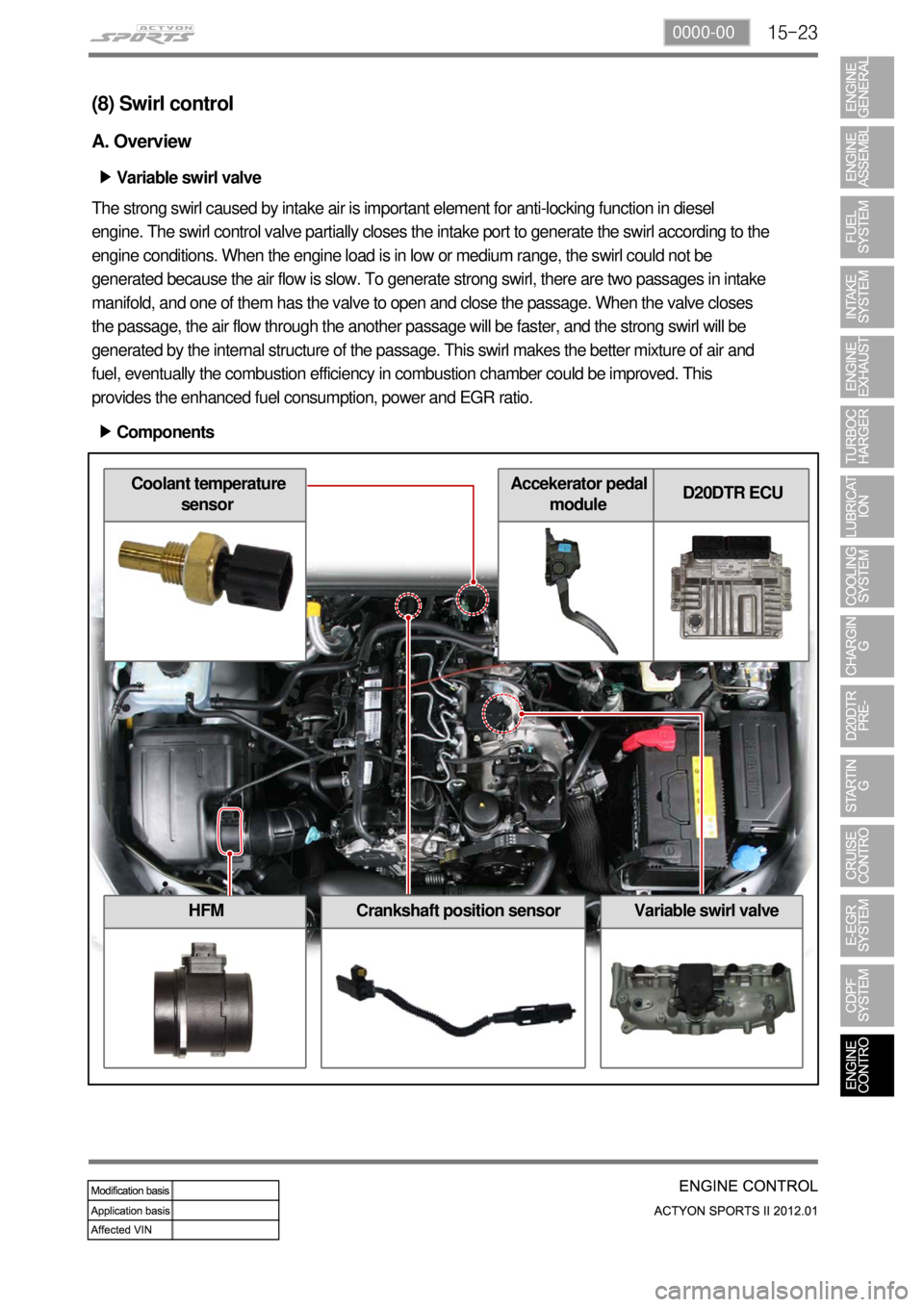2012 SSANGYONG NEW ACTYON SPORTS coolant
[x] Cancel search: coolantPage 317 of 828

15-14
Pilot injection timing control ▶
The pilot injection timing is determined as a function of the engine speed and of the total flow.
The elements are:
A first correction is made according to the air and coolant temperatures. This correction allows
the pilot injection timing to be adapted to the operating temperature of the engine.
A second correction is made according to the atmospheric pressure. This correction is used to
adapt the pilot injection timing as a function of the atmospheric pressure and therefore the
altitude. -
-
(4) Injection Timing Control
Injection timing is determined by the conditions below. ▶
Coolant temperature
Hot engine - Retarded to reduce Nox
Cold engine - Advanced to optimize the combustion 1.
Atmospheric pressure
Advanced according to the altitude 2.
Warming up
Advanced during warming up in cold engine 3.
Rail pressure
Retarded to prevent knocking when the rail pressure is high 4.
EEGR ratio
Advanced to decrease the cylinder temperature when EGR ratio increases 5.
Main injection timing control ▶
The pulse necessary for the main injection is determined as a function of the engine speed and of
the injected flow.
The elements are:
A first correction is made according to the air and coolant temperatures.
This correction makes it possible to adapt the timing to the operating temperature of the
engine. When the engine is warm, the timing can be retarded to reduce the combustion
temperature and polluting emissions (NOx). When the engine is cold, the timing advance must
be sufficient to allow the combustion to begin correctly.
A second correction is made according to the atmospheric pressure.
This correction is used to adapt the timing advance as a function of the atmospheric pressure
and therefore the altitude.
A third correction is made according to the coolant temperature and the time which has
passed since starting.
This correction allows the injection timing advance to be increased while the engine is warming
up (initial 30 seconds). The purpose of this correction is to reduce the misfiring and instabilities
which are liable to occur after a cold start. -
-
-
Page 319 of 828

15-16
B. Driver Demand
The driver demand is the translation of the pedal position into the fuel demand. It is calculated as
a function of the pedal position and of the engine speed. The driver demand is filtered in order to
limit the hesitations caused by rapid changes of the pedal position. A mapping determines the
maximum fuel which can be injected as a function of the driver demand and the rail pressure.
Since the flow is proportional to the injection time and to the square root of the injection pressure,
it is necessary to limit the flow according to the pressure in order to avoid extending the injection
for too long into the engine cycle. The system compares the driver demand with this limit and
chooses the smaller of the 2 values. The driver demand is then corrected according to the
coolant temperature. This correction is added to the driver demand.
Page 320 of 828

15-170000-00
C. Idle Speed Controller
The idle speed controller consists of 2 principal modules:
The first module determines the required idle speed according to:
* The operating conditions of the engine (coolant temperature, gear engaged)
* Any activation of the electrical consumers (power steering, air conditioning, others)
* The battery voltage
* The presence of any faults liable to interface with the rail pressure control or the injection
control. In this case, increase the idle speed to prevent the engine from stalling.
The second module is responsible for providing closed loop control of the engine's idle speed
by adapting the minimum fuel according to the difference between the required idle speed and
the engine speed. -
-
D. Flow Limitation
The flow limitation strategy is based on the following strategies:
The flow limitation depending on the filling of the engine with air is determined according to
the engine speed and the air flow. This limitation allows smoke emissions to be reduced
during stabilized running.
The flow limitation depending on the atmospheric pressure is determined according to the
engine speed and the atmospheric pressure. It allows smoke emissions to be reduced
when driving at altitude.
The full load flow curve is determined according to the gear engaged and the engine
speed. It allows the maximum torque delivered by the engine to be limited.
A performance limitation is introduced if faults liable to upset the rail pressure control or the
injection control are detected by the system. In this case, and depending on the gravity of
the fault, the system activates: -
-
-
-
Reduced fuel logic 1: Guarantees 75 % of the performance without limiting the engine speed.
Reduced fuel logic 2: Guarantees 50 % of the performance with the engine speed limited to
3,000 rpm.
Reduce fuel logic 3: Limits the engine speed to 2,000 rpm.
The system chooses the lowest of all values.
A correction depending on the coolant temperature is added to the flow limitation. This correction
makes it possible to reduce the mechanical stresses while the engine is warming up.
The correction is determined according to the coolant temperature, the engine speed and the
time which has passed since starting.
E. Superchager Flow Demand
The supercharge flow is calculated according to the engine speed and the coolant temperature. A
correction depending on the air temperature and the atmospheric pressure is made in order to
increase the supercharge flow during cold starts. It is possible to alter the supercharge flow value
by adding a flow offset with the aid of the diagnostic tool
Page 321 of 828

15-18
F. Pilot Flow Control
The pilot flow represents the amount of fuel injected into the cylinder during the pilot injection.
This amount is determined according to the engine speed and the total flow.
A first correction is made according to the air and water temperature.
This correction allows the pilot flow to be adapted to the operating temperature of the
engine. When the engine is warm, the ignition time decreases because the end-of-
compression temperature is higher. The pilot flow can therefore be reduced because there is
obviously less combustion noise when the engine is warm.
A second correction is made according to the atmospheric pressure. -
-
During starting, the pilot flow is determined on the basis of the engine speed and the coolant
temperature.
G. Cylinder Balancing Strategy
Balancing of the point to point flows ▶
The pulse of each injector is corrected according to the difference in instantaneous speed
measured between 2 successive injectors.
The instantaneous speeds on two successive injections are first calculated.
The difference between these two instantaneous speeds is then calculated.
Finally, the time to be added to the main injection pulse for the different injectors is determined.
For each injector, this time is calculated according to the initial offset of the injector and the
instantaneous speed difference.
Detection of an injector which has stuck closed ▶
The cylinder balancing strategy also allows the detection of an injector which has stuck closed.
The difference in instantaneous speed between 2 successive injections then exceeds a
predefined threshold. In this case, a fault is signaled by the system.
Page 323 of 828

15-20
C. Learning Conditions
Idle MDP learning Drive MDP learning
Coolant temperatureover 60℃ over 60℃
Vehicle speedIdling over 50km/h (over 5 seconds)
Engine rpm2,000 to 2,500 rpm
Fuel temperature0 < Fuel temperature < 80℃
Learning2 times for each cylinder (every
5 seconds)2 times for each cylinder
(every 5 seconds)
If MDP learning is not properly performed, engine vibration and injection could be occurred.
MDP learning should be performed after replacing ECU, reprogramming and replacing
injector. -
-
D. Injector characteristic curve for rail pressure
Page 326 of 828

15-230000-00
(8) Swirl control
A. Overview
Variable swirl valve ▶
The strong swirl caused by intake air is important element for anti-locking function in diesel
engine. The swirl control valve partially closes the intake port to generate the swirl according to the
engine conditions. When the engine load is in low or medium range, the swirl could not be
generated because the air flow is slow. To generate strong swirl, there are two passages in intake
manifold, and one of them has the valve to open and close the passage. When the valve closes
the passage, the air flow through the another passage will be faster, and the strong swirl will be
generated by the internal structure of the passage. This swirl makes the better mixture of air and
fuel, eventually the combustion efficiency in combustion chamber could be improved. This
provides the enhanced fuel consumption, power and EGR ratio.
Components ▶
HFMCrankshaft position sensorVariable swirl valve
Coolant temperature
sensorAccekerator pedal
moduleD20DTR ECU
Page 330 of 828

15-270000-00
(9) EGR control
A. Overview
The EGR (Electric-Exhaust Gas Recirculation) valve reduces the NOx emission level by
recirculating some of the exhaust gas to the intake system.
To meet Euro-V regulation, the capacity and response rate of E-EGR valve in D20DTR engine
have been greatly improved. The EGR cooler with high capacity reduces the Nox, and the bypass
valve reduces the CO and HC due to EGR gas before warming up.
Also, the engine ECU adjusts the E-EGR opening by using the air mass signal through HFM
sensor. If the exhaust gas gets into the intake manifold when the EGR valve is open, the amount
of fresh air through HFM sensor should be decresed.
B. Components
E-EGR cooler
Accelerator pedal
moduleD20DTR ECU
Coolant
temperature senso
r
Oxygen sensor
HFM (intake air
temperature)Electric throttle
body
Crankshaft position
sensor
E-EGR valve
T-MAP sensor
Page 332 of 828

15-290000-00
D. Bypass control for EGR cooler
Cooler temperature ▶
<007e008f008c00950047009b008f008c0047008a00960096009300880095009b0047009b008c00940097008c00990088009b009c0099008c00470090009a00470089008c00930096009e0047005e00570b4500530047009b008f008c0047008c009f008f00
88009c009a009b0047008e0088009a00470090009a00470089>ypassed the EGR cooler.
Exhaust gas temperature ▶
<007e008f008c00950047009b008f008c0047008c009f008f0088009c009a009b0047008e0088009a0047009b008c00940097008c00990088009b009c0099008c00470090009a00470089008c00930096009e0047005a005700570b4500530047009b008f00
8c0047008c009f008f0088009c009a009b0047008e0088009a> is bypassed the EGR cooler.
Otherwise, PM could be increased due to too low exhaust gas temperature.
E. Control elements for EGR system
Accelerator pedal (engine load) - Indicates the driver's intention and engine load. If the load
goes up, the EGR ratio is decreased.
T-MAP (boost pressure map stored in ECU) - Compensates the difference in boost pressure
by adjusting EGR ratio.
Engine rpm - Used as the signal for determining EGR operating range.
Coolant temperature - When the coolant temperature is low, NOx is decreased but PM could
be increased. So, to reduce PM, decrease EGR ratio when the coolant temperature is low.
Intake air mass and temperature - HFM sensor measures the intake air mass to calculate the
actual EGR volume. If the air mass is larger than programmed value in map, EGR ratio will be
higher.
EGR position sensor - Detects the actual opening angle of EGR valve and performs feedback
function according to PWM control by ECU.
Wide band oxygen sensor - Detects the oxygen volume in exhaust gas to check if the EGR
ratio is proper.
Electronic throttle body - Keeps EGR ratio to optimized level by controlling the throttle body in
EGR operating range (decreasing pressure in intake manifold). -
-
-
-
-
-
-